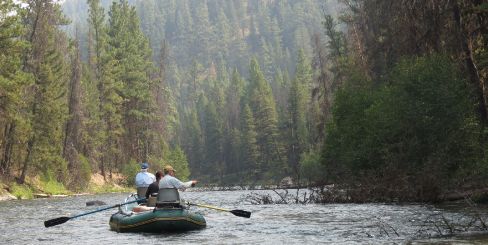Fort Collins, Colorado-based fly tier Eric Ishiwata is a dedicated student of the swung fly. And his basic design principles fall into four essential categories: profile, color, flash, and size. By fine-tuning those attributes, Ishiwata’s flowing streamers, built to excel with a traditional down-and-across wet-fly presentation, have proven effective from Wyoming and Montana to larger coastal rivers up and down the Pacific Northwest. Here’s why.
“There are a couple of ways of thinking about fly size,” Ishiwata says. “One is to consider the food sources in the system. If the river is loaded with 2-inch leeches and 3-inch sculpins, it makes sense to have your streamers follow suit.” His other rule is to tie flies geared toward the fish you want to catch. “Flies should be large enough to eliminate dinks, yet reasonable enough to produce the kind of numbers you’d like.” While swinging an 8-inch hunk of meat may eventually produce a trophy brown, the question is, When? In order to have the best odds for a “good” day, Ishiwata fishes a range of patterns between 2.5- and 4 inches long—although he’s not opposed to chucking bigger bugs.
In addition to fly size, Ishiwata says profile is the single most important characteristic of swing-style flies. By profile, he’s referring to the shape and movement the fly takes when pulled against the river’s hydraulics.
“Too often, folks focus on how flies look in the vise or bins. While dead-drifted dries and nymphs undergo close inspection, making the case—perhaps—for anatomical correctness, and jerk-stripped articulates are built to trigger impulse reactions, swing-style flies swim across the river at a near-constant pace,” he says. “I want my flies to replicate the profile and swimming movement of sculpins, crayfish, parr, and other baitfish. From a trout’s eye view—I suspect—a swinging streamer is more of a blur than a Quigley Cripple but less pandemonium than an Articulated Zoo Cougar.”
Color is also critical. “There have been way too many times where a buddy and I have worked the same run, casting at similar angles, swinging at similar depths, and one of us was totally on the fish and the other completely off, with the only perceptible difference being the color of our flies,” he says. Over the years, Ishiwata has developed a handful of mini-theories (for instance, white/chartreuse for lake-run rainbows, black/copper for overcast skies, and olive/brown in the fall) that work as a general frame of reference. However, those theories have also been occasionally debunked by obstinate trout. Therefore, Ishiwata ties all of his patterns in multiple color combinations—between three and seven schemes depending upon the pattern.
Last but not least is the element of flash. There was a period of time when Ishiwata only dabbled in natural materials. “I loved the classic aesthetics and bought-in wholesale to legends like Rene Harrop who preach the superiority of CDC, marabou, and pheasant,” he says.
“But I had too many days when Bubbas in blue jeans simply destroyed me using Mepps spinners. The reality is that there are times where loud and obnoxious flies outperform their drab cousins. Conversely, there are times where gaudy flies will absolutely turn trout off and this transition can take place from one hour to the next.”
For now, Ishiwata continues to be inspired by everything from Spey-style PNW steelhead patterns to Chris Schrantz’s deadly Platte River Spider. And translating anadromous-oriented concepts into flies such as his Grand Master Flash continues to produce slam-dunk swinging across a variety of waters.
[This is an excerpt from What A Trout Sees: A Fly-Fishing Guide to Life Underwater, Lyons Press, 2013. You can purchase the book online at barnesandnoble.com.]
---
Grand Master Flash by Eric Ishiwata, Idylwilde Flies
Hook: Any hook with 1.5-inch long shankThread: 8/0 Uni (wine)Tag: Firewire loop, extended 1 inch past shank, 20lb mono loop half the length of FirewireButt: Med. Cactus Chenille (pearl), pheasant church window featherTail: 2 pairs ostrich at 10 and 2 (black)Abdomen: Cream wool yarnThorax: Trout bead (any color)Hackle: Whiting American Rooster Saddle (white dyed tan)Flash: ~10-14 strands Flashabou (copper)Wing: 6-8 strands ostrich herl (black)Throat: 2 turns hen hackle (rust)Horns: 2-inch long grizzly saddles tied at 10 and 2Head: Hareline Pseudo Hair in dubbing loop (black)Eyes: Med. Lead DumbbellsTrailer: #6 Gamakatsu Octopus
Alternative Color Combos: 1. tan/gold, 2. olive/copper, and 3. black/blue.








